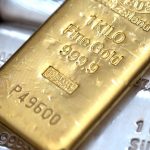Gold pared its daily losses on Wednesday as the US dollar retreated after downbeat producer inflation and retail sales data eased speculations of an earlier-than-expected interest rate hike by the Federal Reserve. Copper retreated from a 3-1/2 week high following overall downbeat inflation data from China.
Comex gold for settlement in December reversed earlier losses and rose by 0.13% by 13:06 GMT to $1 235.9 per troy ounce, having hit a fresh four-week high of $1 239.6. The precious metal rose for a second day on Tuesday and settled 0.35% higher at $1 234.3.
The US dollar index fell sharply on Wednesday after the Labor Department reported that producer price inflation contracted by 0.1% on a monthly basis in September after remaining flat a month earlier, defying analysts projections for a 0.1% jump. Year-on-year, the Producer Price Index marked a 1.6% rise, trailing projections and the preceding months 1.8% gain. Core PPI also underperformed analysts anticipations.
A separate report by the Department of Commerce showed that retail sales plunged 0.3% last month after adding 0.6% in August. This was the poorest performance since January and trailed analystss preliminary estimates for a 0.1% decline. Core retail sales, which exclude the volatile automobile sales, slid 0.2%, the most since March 2013, confounding projections and the preceding months 0.3% jump.
The US dollar index for settlement in December had traded higher throughout the day, having touched 86.130 earlier, the strongest level since October 7th. The contract reversed following the release of the data to a session low of 85.250 and stood at 85.340 at 13:22 GMT.
Gold drew support from the weaker dollar, but also from rising global economic uncertainty following the recent downbeat economic data from Europe. Major EU economies posted sluggish inflation numbers, while the Eurozone’s industrial production contracted in August both on monthly and year-on-year basis. A gauge of investor confidence for the single currency bloc fell for a tenth month, while both current conditions assessment and economic sentiment in Germany were also much worse than expected.
Federal Reserve Vice Chairman Stanley Fischer said on October 11th that weaker-than-expected global growth could force the Fed to remove accommodation slower than otherwise. He said that the central bank won’t raise interest rates until the US economic growth has advanced sufficiently and emerging markets could digest the interest rate hike. An extended period of rock-bottom interest rates would benefit gold as a non-interest-bearing asset, while pushing the dollar down.
Physical demand from the metal’s top two buyers also lent some support. India’s gold imports almost doubled in September to $3.75 billion from a month earlier, ahead of the nation’s wedding and festival season. In China, the leading global consumer, physical trading on the Shanghai Gold Exchange remained very active with premiums hovering around $4 per troy ounce.
Assets in the SPDR Gold Trust, the biggest bullion-backed ETF and a major gauge of investor sentiment towards the metal, remained unchanged at 761.23 tons on Tuesday, after they rose on Monday for the first time since September 10th.
Copper
Copper retreated from a 3-1/2-week high on Wednesday as overall downbeat inflation data from China spurred fears of an economic slowdown, while also opening up space for monetary easing, and as manufacturing activity in the New York region fell to a 6-month low.
Comex copper for delivery in December plunged 1.41% by 13:06 GMT to trade at $3.0465 per pound, having shifted in a daily range of $3.0850-$3.0395. The industrial metal rose by 1.63% on Tuesday to $3.0900 a pound, its third straight daily advance, having risen to an intraday high of $3.1045 which was the strongest level since September 19th.
Prices retreated from yesterdays high after overall downbeat inflation data from China renewed fears of an economic slowdown. China’s National Bureau of Statistics reported that consumer prices rose by 0.5% in September from a month earlier, beating projections for a 0.4% gain. Year-on-year, CPI was up 1.6%, trailing the preceding month’s 2.0% jump and slightly below economists’ 1.7% projection. Producer prices fell for the 31st consecutive month, down 1.8% in September from a year earlier.
Tetsu Emori, a senior fund manager at Astmax Asset Management Inc. in Tokyo, said for Bloomberg: “The inflation number is very, very low. It seems the demand side is much weaker than we expected.”
Meanwhile, the Federal Reserve bank of New York reported that its NY Empire State Manufacturing Index slid to 6.17 in October from 27.54 a month earlier, trailing projections for a moderate drop to 20.50. This marked the worst level of business conditions in the region since April.
Sluggish data from Europe, coupled with Germany trimming its growth forecasts for 2014 and 2015 also raised concerns over demand for the metal, which is widely used in construction and wiring.
Prices, however, drew some support by previous positive data from China, as well as expectations for monetary easing.
China’s central bank cut an interest rate it pays lenders for the second time this month yesterday. The reduction spurred speculations of broad-based monetary easing, which would help small business and public housing.
A senior official at China’s economic planner said the nation’s investment growth should accelerate in the months to come as the government speeds up infrastructure projects. Upbeat trade data by China’s customs agency also lent some aid to the markets.
Also benefiting short-term prices, industry group the International Copper Study Group said the global copper market will experience a deficit for the fifth consecutive year in 2014, before jumping to a surplus of around 390 000 tons in 2015.





